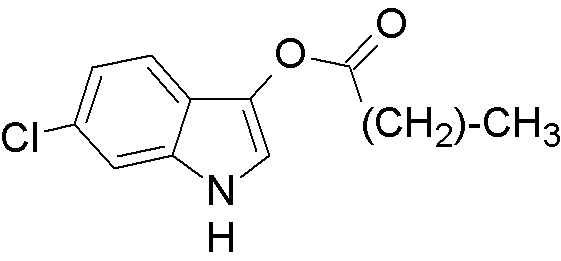6-Chloro-3-indoxyl butyrate is widely utilized in research focused on:
- Biochemical Assays: This compound serves as a substrate in enzyme assays, particularly for studying β-glucuronidase activity, which is crucial in drug metabolism research.
- Histochemical Staining: It is employed in histochemistry for visualizing specific cellular components, aiding in the identification of tissue types and disease states.
- Pharmaceutical Development: Researchers use it to develop and test new drugs, particularly in the field of cancer research, due to its potential to target specific cellular pathways.
- Plant Biology: This chemical is used in plant research to study gene expression and metabolic pathways, providing insights into plant development and responses to environmental stress.
- Diagnostic Tools: It has applications in creating diagnostic reagents for detecting certain diseases, enhancing the accuracy of medical tests.
General Information
Properties
Safety and Regulations
Applications
6-Chloro-3-indoxyl butyrate is widely utilized in research focused on:
- Biochemical Assays: This compound serves as a substrate in enzyme assays, particularly for studying β-glucuronidase activity, which is crucial in drug metabolism research.
- Histochemical Staining: It is employed in histochemistry for visualizing specific cellular components, aiding in the identification of tissue types and disease states.
- Pharmaceutical Development: Researchers use it to develop and test new drugs, particularly in the field of cancer research, due to its potential to target specific cellular pathways.
- Plant Biology: This chemical is used in plant research to study gene expression and metabolic pathways, providing insights into plant development and responses to environmental stress.
- Diagnostic Tools: It has applications in creating diagnostic reagents for detecting certain diseases, enhancing the accuracy of medical tests.
Documents
Safety Data Sheets (SDS)
The SDS provides comprehensive safety information on handling, storage, and disposal of the product.
Product Specification (PS)
The PS provides a comprehensive breakdown of the product’s properties, including chemical composition, physical state, purity, and storage requirements. It also details acceptable quality ranges and the product's intended applications.
Certificates of Analysis (COA)
Search for Certificates of Analysis (COA) by entering the products Lot Number. Lot and Batch Numbers can be found on a product’s label following the words ‘Lot’ or ‘Batch’.
*Catalog Number
*Lot Number
Certificates Of Origin (COO)
This COO confirms the country where the product was manufactured, and also details the materials and components used in it and whether it is derived from natural, synthetic, or other specific sources. This certificate may be required for customs, trade, and regulatory compliance.
*Catalog Number
*Lot Number
Safety Data Sheets (SDS)
The SDS provides comprehensive safety information on handling, storage, and disposal of the product.
DownloadProduct Specification (PS)
The PS provides a comprehensive breakdown of the product’s properties, including chemical composition, physical state, purity, and storage requirements. It also details acceptable quality ranges and the product's intended applications.
DownloadCertificates of Analysis (COA)
Search for Certificates of Analysis (COA) by entering the products Lot Number. Lot and Batch Numbers can be found on a product’s label following the words ‘Lot’ or ‘Batch’.
*Catalog Number
*Lot Number
Certificates Of Origin (COO)
This COO confirms the country where the product was manufactured, and also details the materials and components used in it and whether it is derived from natural, synthetic, or other specific sources. This certificate may be required for customs, trade, and regulatory compliance.


